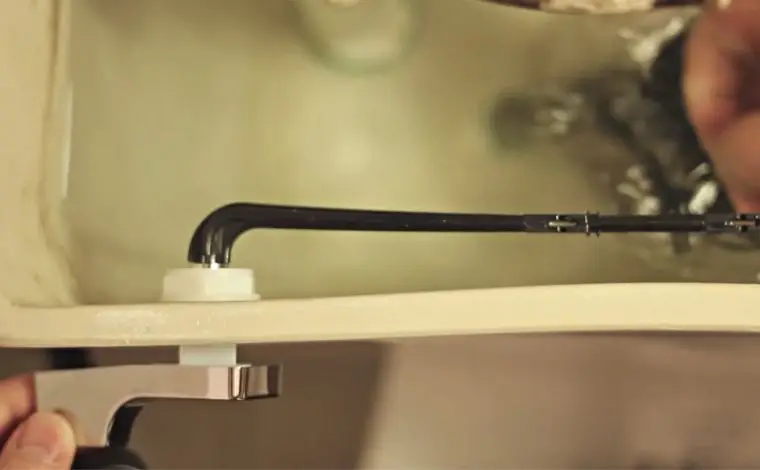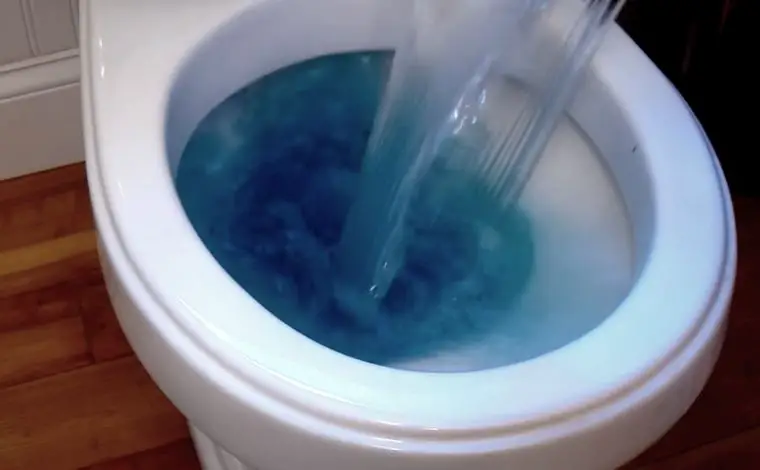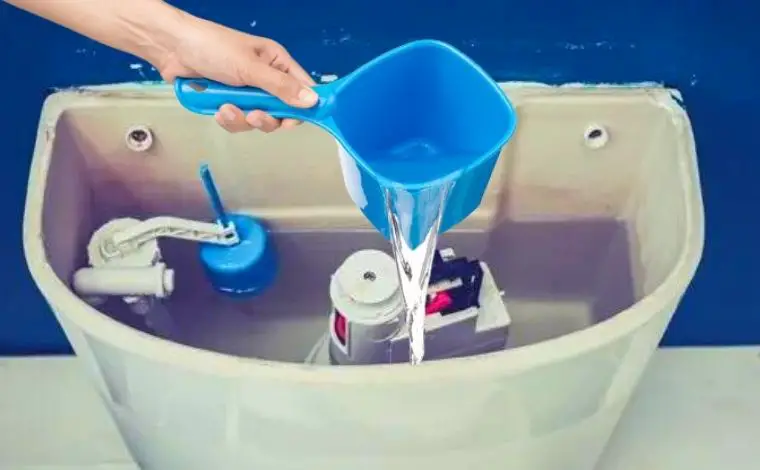If your toilet handle breaks suddenly, it can feel like a mini crisis — especially when you need to use the bathroom right away. Don’t panic! The good news is that you can still flush a toilet without using the handle.
Normally, if your toilet flushes smoothly with enough water pressure and refills quickly, your toilet’s flushing system is working perfectly. But when the handle stops working, it doesn’t mean you can’t flush. In this article, you’ll learn why toilet handles break, how they work, and the three easiest methods to flush your toilet without a handle — safely and effectively.
How Does a Toilet Handle Work?
Most modern toilets — such as the Toto Legato One-Piece High Efficiency Toilet — use a handle located on the top left or right side of the water tank. The handle’s purpose is simple but essential: it releases the water from the tank into the toilet bowl to wash away waste.
When you press the handle, it lifts a chain connected to a flapper valve inside the tank. This action allows water to rush down into the bowl. The pressure and gravity combined help move waste through the drain. Once the tank empties, the flapper closes, and the tank begins refilling for the next flush.
In short:
-
The handle acts like a lever.
-
The chain lifts the flapper.
-
The flapper releases the water into the bowl.
-
The fill valve refills the tank afterward.
If the handle breaks or the chain disconnects, you can’t lift the flapper normally — but you can still do it manually.
Why Toilet Handles Break
Toilet handles are mechanical parts that wear out over time. Here are the most common reasons they fail:
-
Worn-out rubber seal – The seal (gasket) under the flush valve weakens over time and can cause the handle to loosen or malfunction.
-
Rust or corrosion – In older toilets, metal rods or nuts may rust and break, making the handle stiff or useless.
-
Loose chain connection – If the chain inside the tank detaches from the handle lever, the flapper won’t lift when you press the handle.
-
Plastic fatigue – Many newer handles are plastic. Repeated use can make them brittle and eventually snap.
-
Improper installation – If the handle isn’t aligned correctly, it can jam or break with frequent use.
👉 If your handle breaks frequently, you may want to learn how to change a toilet handle properly to avoid future issues.
Can You Flush a Toilet Without a Handle?
Yes, absolutely. Even if the handle is broken, you can flush your toilet manually. All you need is to access the tank or use enough water pressure to simulate a normal flush. There are three proven methods you can use:
-
Lifting the flapper manually
-
Pouring water directly into the toilet bowl
-
Filling the tank and lifting the flapper chain
Let’s go step by step.
Method 1: Elevate the Flapper
If the handle doesn’t work, the easiest fix is to lift the flapper manually inside the tank.
Here’s how:
-
Remove the tank lid – Gently take off the tank lid and set it on a flat surface to avoid cracks.
-
Locate the flapper – The flapper is a rubber disk (usually red or black) at the bottom center of the tank. It’s attached to a small chain that connects to the handle lever.
-
Lift the chain or flapper – If the chain is still connected, pull it upward. This action opens the flapper and releases the stored water into the bowl — just like a regular flush.
-
Wait for the flush to complete – Once the water empties from the tank, release the chain so the flapper closes again.
💧 Note: The tank water is clean — it’s the same water that fills your sink — so don’t worry about hygiene while touching it.
If the chain is disconnected, use your hand (or a clean stick) to lift the rubber flapper directly. The moment it rises, you’ll hear water rushing into the bowl, performing a full flush.
Once done, check if about one inch of water remains at the tank’s bottom. If not, you may need to use another method below to ensure a complete flush.
Method 2: Pour Water Directly into the Toilet Bowl
If the tank system is not working or is empty, you can flush using gravity power by pouring water straight into the bowl. This is one of the simplest emergency methods and works surprisingly well.
Steps:
-
Fill a large bucket (about 2–5 gallons) with clean water.
-
Pour quickly and forcefully into the toilet bowl. Aim for the center, and pour all at once — not slowly.
-
Observe the flush effect. The sudden surge of water pressure will push waste down the drain, mimicking a standard flush.
You’ll see the bowl empty and refill slightly, leaving it clean.
If your bucket is smaller, repeat the process twice for better results. Always use clean water to maintain hygiene.
This method works best if:
-
The water supply is temporarily cut off.
-
The tank or handle mechanism is broken.
-
You’re cleaning an old toilet that doesn’t refill automatically.
💡 Pro Tip: Pouring from a higher height increases water pressure, improving flushing efficiency.
Method 3: Pour Water Into the Tank
If your toilet tank is empty or the refill valve is broken, you can fill it manually and flush from there.
Here’s how:
-
Open the tank lid carefully.
-
Check the water level. Most tanks need about 1.5–2 gallons of water to flush properly.
-
Pour water into the tank using a bucket or jug until it’s about an inch below the overflow tube.
-
Lift the flapper manually (or pull the chain). This releases the stored water into the bowl, performing a normal flush.
This method works great if your handle or lever is broken but the rest of the flushing mechanism still functions. It’s also the cleanest way to mimic a standard flush since the water flows through the same path.
For reference, this process gives you almost the same result as using the handle.
Bonus Tip: Keep It Hygienic
To maintain hygiene and prevent odor:
-
Always wash your hands after touching the tank water.
-
Add a small amount of detergent or toilet cleaner when pouring water manually.
-
Occasionally clean the flapper and chain to prevent calcium or rust buildup.
You can also use eco-friendly toilet cleaning tablets to keep the bowl fresh and stain-free between flushes.
When Should You Replace the Handle?
While manual methods are helpful in emergencies, replacing the handle is a long-term solution. You should replace the handle when:
-
The handle feels loose or doesn’t spring back.
-
You notice rust or cracks on the lever.
-
The chain frequently disconnects.
-
The flapper doesn’t open even after multiple tries.
Replacing it takes just 5–10 minutes. You can follow this step-by-step guide:
Quick Troubleshooting Tips
If you still have flushing problems after using these methods, check for the following:
-
Chain length: Too short or too long chains may prevent proper flapper movement.
-
Flapper seal: Replace it if you notice constant water leakage into the bowl.
-
Fill valve: Clean the valve if the tank refills too slowly.
-
Overflow tube: Ensure it’s not cracked or misaligned.
For deeper cleaning or mechanical fixes, see:
➡️ Common Toilet Flushing Problems and Fixes
Final Thoughts: The Best Alternatives to a Broken Toilet Handle
Flushing a toilet without a handle might seem inconvenient, but it’s completely manageable. You just need a bit of creativity and understanding of how the flushing mechanism works.
Among all methods:
-
Pouring water into the bowl is the fastest.
-
Lifting the flapper manually is the most precise.
-
Filling the tank manually gives you the most natural flush.
If you combine any of these with a small amount of detergent, your toilet will stay clean, odor-free, and hygienic — even without a working handle.
Remember, these are temporary solutions. A permanent fix is always to replace or repair your handle to restore convenience and water efficiency.
FAQs
🔹 Why do toilet handles break?
The main reason is a worn or damaged flush valve seal. This rubber ring weakens with frequent use. Over time, it can cause pressure imbalance, making the handle harder to press until it finally breaks. Regular maintenance and timely replacement can prevent this.
🔹 Is it safe to flush without a handle?
Yes. All three methods — lifting the flapper, pouring water into the bowl, or into the tank — are completely safe and effective. Just remember to use clean water and maintain hygiene afterward.
🔹 How long does a toilet handle last?
Typically, a good-quality toilet handle lasts 4–5 years. If handled roughly or made of cheap plastic, it may break sooner. For durability, choose metal or chrome-plated replacement handles.
🔹 Can I use any water for manual flushing?
Yes, you can use tap water, stored water, or filtered water. Avoid using dirty or soapy water since it may leave stains or clog the bowl.
🔹 What if the flapper is also broken?
If the flapper doesn’t seal or lift properly, replace it immediately. You can find step-by-step instructions here:
Hi, this is Robert Crossan, the owner of this website, has 17 years of experience in the installation, maintenance, and repair of toilets and plumbing systems. After completing the Level 2 Basic Plumbing course in 2005, I started working in both domestic and commercial buildings as a professional plumber. So I can figure out the core difference between different toilet models and brands. It also helped me monitor their work performance and setbacks.